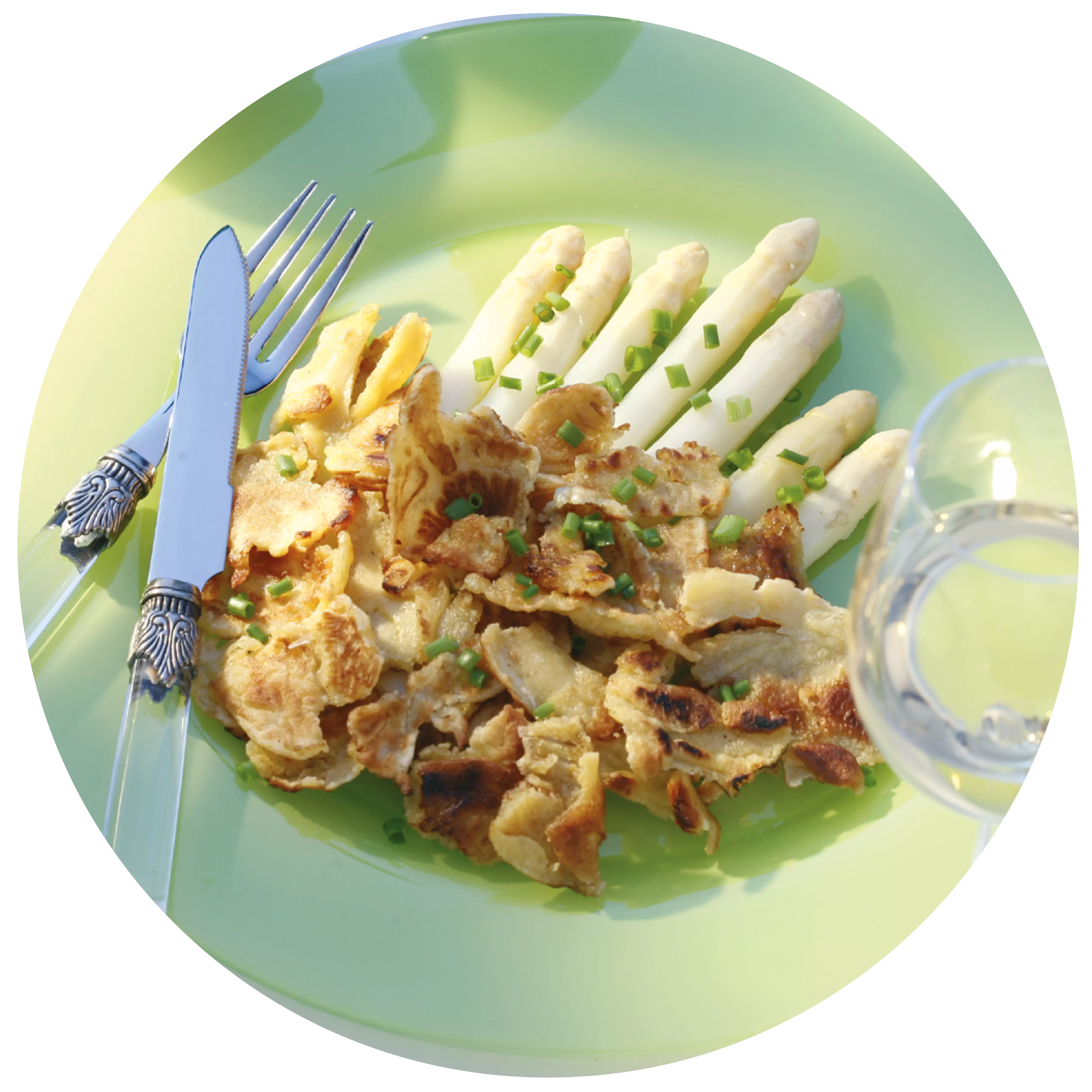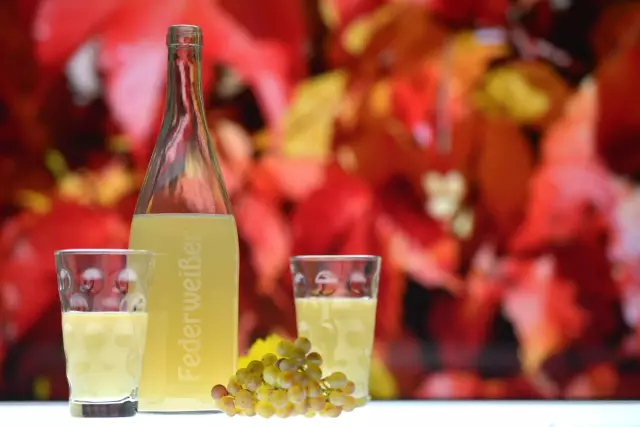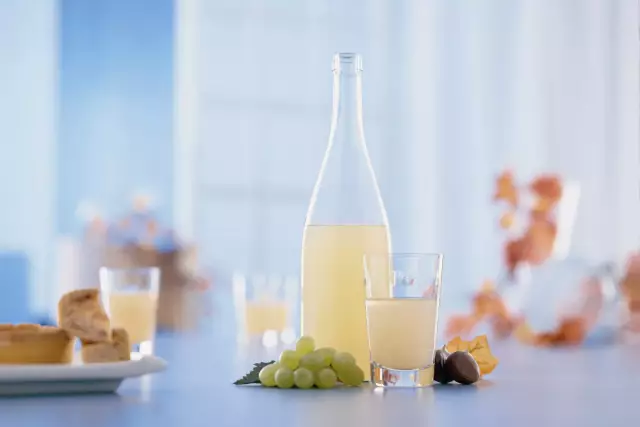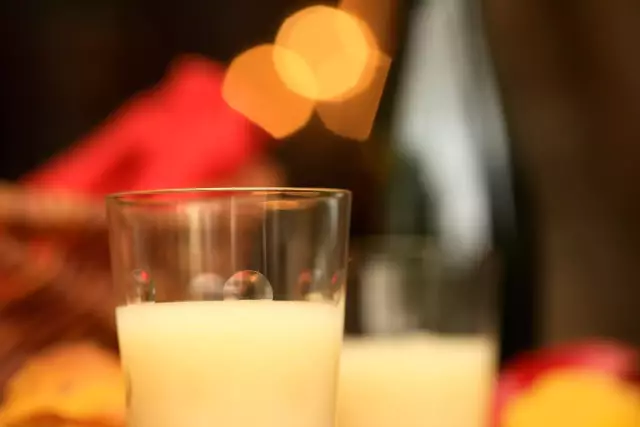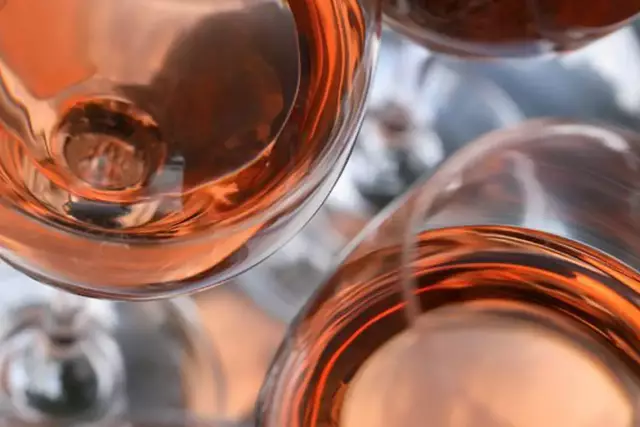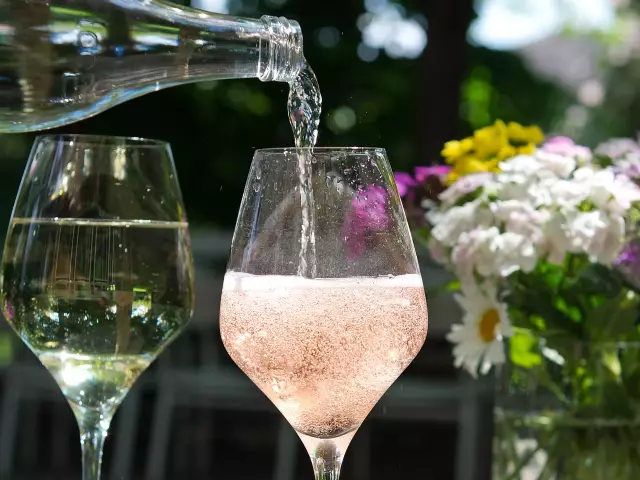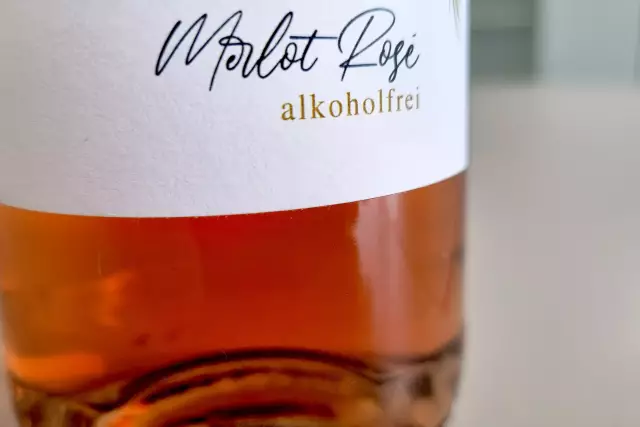New Wine ("Federweißer)
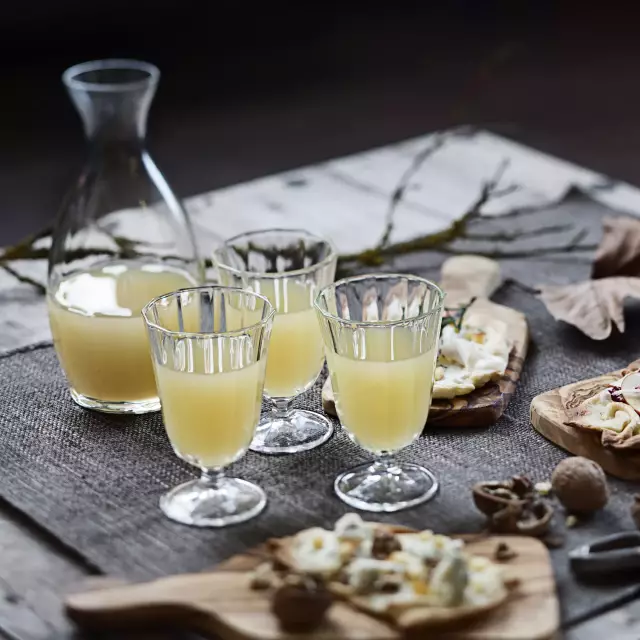
If you hold the glass to your ear, Federweißer (new wine) sounds like murmuring waves. When the time of the grape harvest has come, you can get 'Rauscher', 'Sauser' or 'Brauser', these local terms are used for Federweißer in Germany, on every street corner.
Facts
-
5 %
by volume alcohol content
-
around 2
million liters are sold annually in Rhineland-Palatinate
Steffen Schindler, marketing director for Wines of Germany (DWI), puts it this way: “Federweißer is a pleasure that defines autumn and the grape harvest just as much as a delicious onion tart.” Ideally, you drink Federweißer when it has come half way between grape juice and wine, when sweetness, alcohol content and fruit acidity are well balanced. At this stage, its alcohol content amounts to around 5 % vol. watch video (German language / subtitles)
How to handle Federweißer correctly
Owing to the high demand for the new wine, Federweißer is on offer all over Germany these days and can be bought in supermarkets as well as specialist wine stores. But you have to be careful when you buy it: Since fermentation continues inside the bottle, it should always be sealed with a closure that is permeable to air, so the carbonic acid can escape. The bottle should be transported standing upright at all times. Wines of Germany recommends to taste a little of the Federweißer once you have reached home. If it tastes just right: Straight into the fridge it goes, because the cold puts a stop to the fermentation process and you will be able to enjoy a perfect Federweißer for a little longer. (Video of Federweisser harvest)
If the Federweißer still tastes too sweet, keep it at room temperature and have another taste after 6-8 hours. Once the perfect degree of sweetness has been achieved, store the Federweißer in the fridge.
How much Federweißer is sold per year?
In Rhineland-Palatinate alone, about two million liters of Federweißer are sold every year.
Varietals

Wine recommendation: A white wine with a mellow flavour such as Pinot Gris or Chardonnay. Asparagus risotto al scampi
Risotto with green asparagus, scampi and parmesan.
- 400g Grüner Spargel
- 200g Küchenfertige Scampis
- 200g Risotto-Reis
- 250ml Trockener Weißwein
- 500ml Gemüsebrühe
- 50g Parmesan
- 1 Zwiebel
- 4EL Olivenöl
- 1Dose Safranfäden
- etwas Salz und Pfeffer
Peel the lower third of the asparagus and cut off the ends. Cut into 2 cm long pieces, cook in boiling salted water for approx. 5 minutes and drain. Cut the onion into thin slices and finely chop the garlic.
<p
<p>Heat 2 tbsp of oil, add the onion slices, garlic and rice
.
sauté until translucent. Deglaze with the white wine. Season with salt, pepper
and saffron to flavour. Add a little stock, bring to the boil and simmer, stirring constantly. Gradually add the remaining stock and simmer until the liquid has been absorbed by the rice. The rice should still have a bite on the inside.
Wash the scampi and grate the Parmesan. Heat 2 tbsp oil in a pan and fry the scampi for approx. 4 minutes. Season with salt and pepper. Stir the asparagus, scampi and parmesan into the risotto and serve.
Wine recommendation:
A white wine with a mellow flavour such as Pinot Gris or Chardonnay. Alternatively, a well-chilled, light Trollinger or Blanc de Noir from Pinot Noir.
<p- Grauburgunder / Pinot Gris (extra brut)
- Chardonnay (extra brut)
- Trollinger (brut)
- Spätburgunder / Pinot Noir (brut)
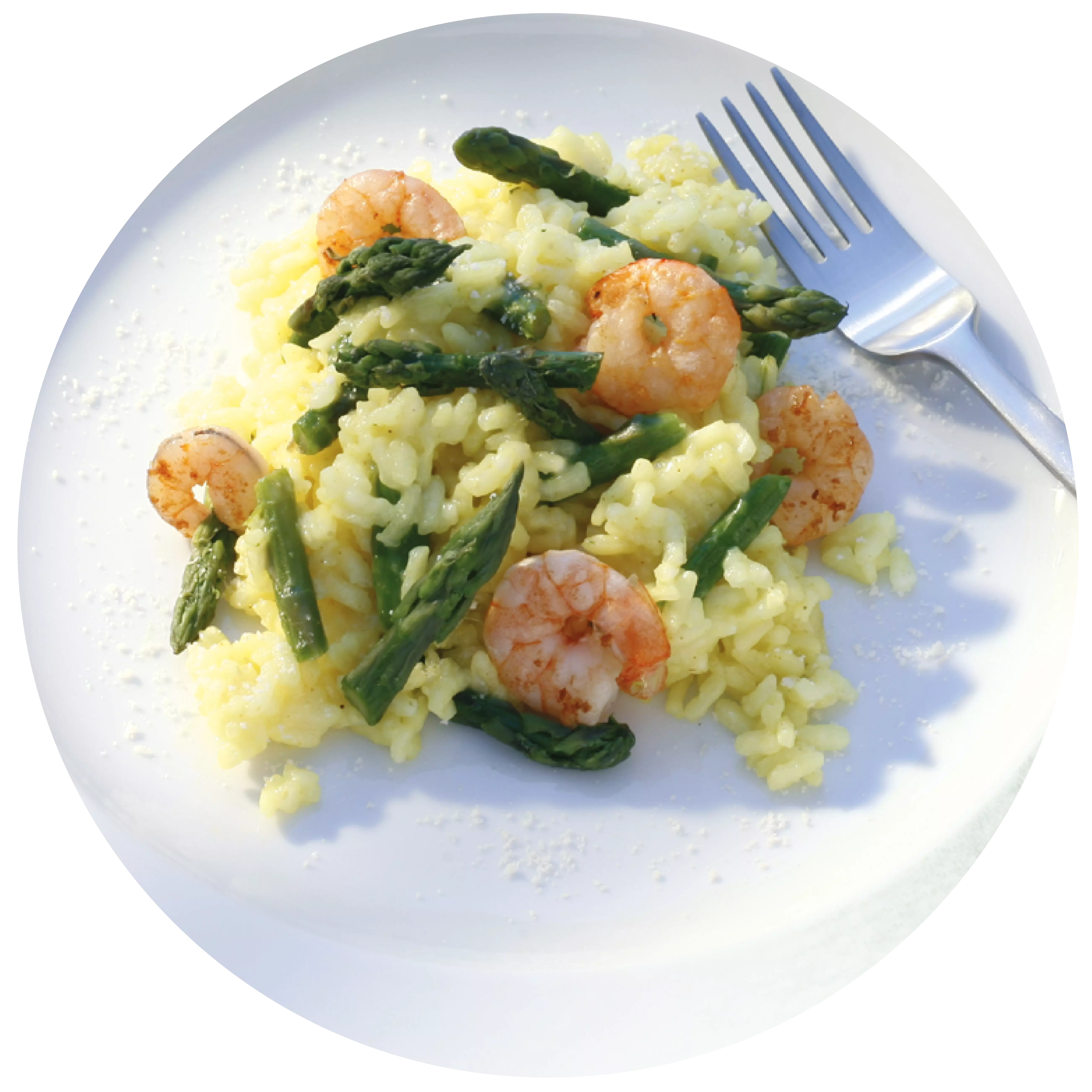
with wild duck breast, porcini mushrooms and glazed chestnuts Herb salad
with wild duck breast, porcini mushrooms and glazed chestnuts
- 150 Gramm Wildkräuter
- 4 EL Olivenöl
- 2 EL Balsamessig
- 8 Stück Wildentenbrüste (a 100g)
- 2 EL Sonnenblumenöl
- 4 EL Honig
- 1 EL Thymian
- 200 Gramm Steinpilze
- 20 gekochte Maronen
- 100 ml Apfelsaft
- 2 El Zucker
- nach Belieben Salz & Pfeffer
Clean, wash and pat dry the wild herbs. Marinate with olive oil and balsamic vinegar and season with salt and pepper.
Preheat the oven to 220°C top and bottom heat. Season the wild duck breasts with salt and pepper, sear on the meat side in a pan with sunflower oil and cook in the preheated oven for about 8 minutes on the skin side. Remove the duck breast, brush the skin side with honey and thyme and roast for another 2 minutes on a high heat until crispy.
Clean the porcini mushrooms and cut into slices. Fry in a pan in oil on both sides, remove and keep warm. Caramelise the sugar in the pan, deglaze with the apple juice and simmer until the caramel has dissolved. Add the chestnuts and add a little more apple juice if necessary.
- Pinot Blanc (trocken)
- Gutedel (trocken)
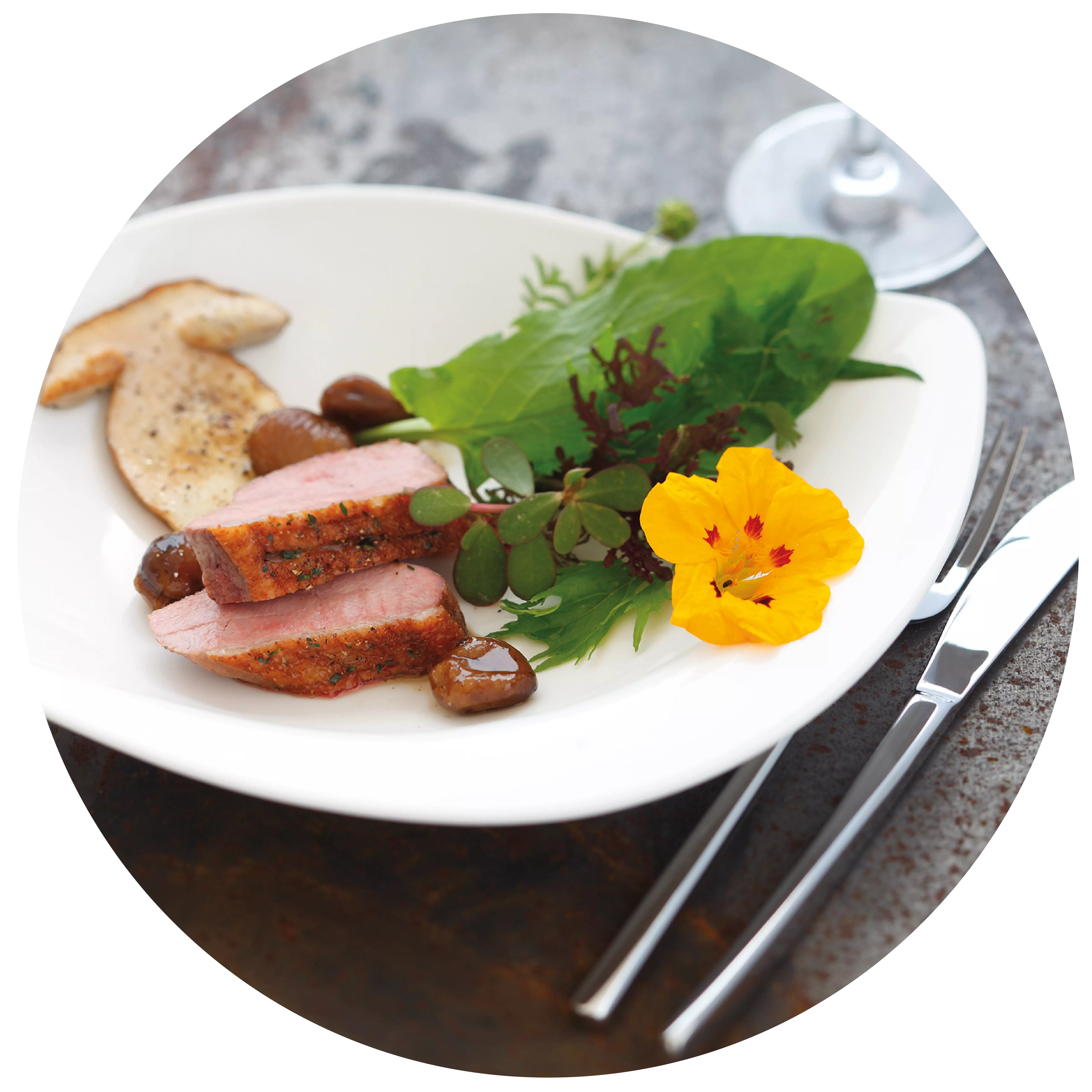
with pears, beans, parsley root and black walnuts Venison medallions
with pears, beans, parsley root and black walnuts
- 12 Stück Rehmedaillions (a 80g)
- 30 Gramm gebratene Speckstreifen
- 200 ml Bechamelsauce
- 3 EL Sonnenblumenöl
- 8 kleine Petersilienwurzeln mit Grün (alternativ Knollensellerie)
- 6 - 8 breite Schnippelbohnen
- 1 große Birne
- 4 - 6 schwarze Walnüsse
- 100 ml Wildfond
- 2 EL Butter
- 2 Stängel glatte Petersilie
- nach Geschmack Salz
Preheat the oven to 180 °C top and bottom heat. Clean, peel and trim the parsley roots. Clean the beans and cut into diagonal pieces. Blanch the parsley roots and beans separately in boiling salted water and rinse immediately in iced water.
Cut the walnuts into eighths and warm in the game stock. Wash the unpeeled pear, cut into eighths, remove the core and cut into thin slices. Fry the venison medallions on both sides in oil, then finish cooking in the oven for approx. 3 - 5 minutes.
In the meantime, toss the beans and parsley roots in melted butter and season with salt. Arrange the vegetables with the black walnuts and pear slices on large plates. Place the medallions on top, garnish with game stock, Béchamel sauce and bacon strips.
Tip: You can make your own black walnuts. To do this, prick the walnuts all over with a fork or skewer and place in water for 10 days. Change the water every day so that the tannic acid can drain off. Boil the nuts 3 times in salted water until they are deep black. Simmer with bay leaves and peppercorns for approx. 20 minutes until soft. Layer in preserving jars and cover with syrup. The nuts can be kept for approx. 1 year.
- Spätburgunder / Pinot Noir (trocken)
- Grauburgunder / Pinot Gris (trocken)
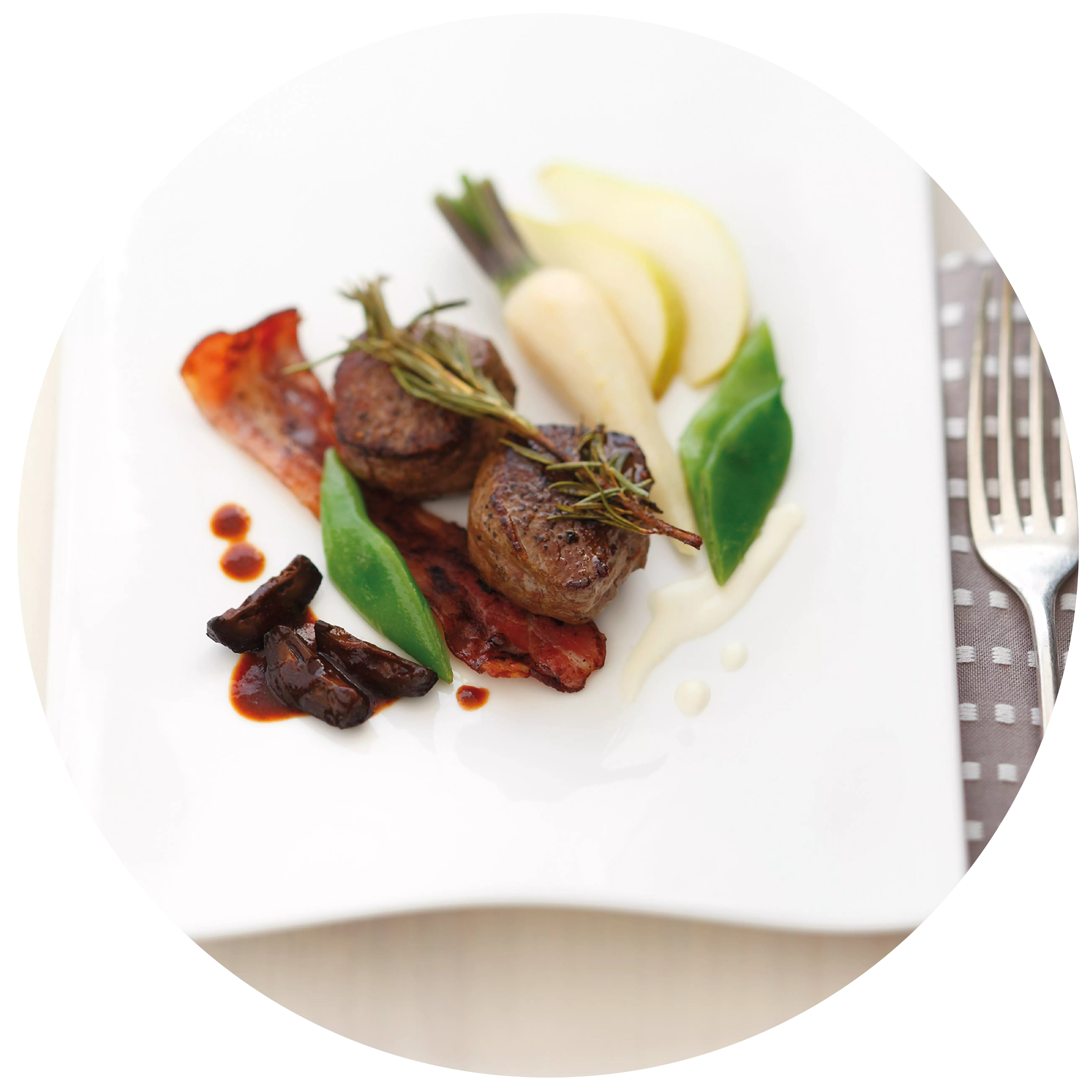
White asparagus with pancake strips Asparagus with "Kratzete"
White asparagus with pancake strips and champagne butter sauce.
- 1kg Weißer Spargel
- 200g Mehl
- 4 Eier
- 150ml Milch
- 1TL Butterschmalz zum Braten
- 2EL Butter
- 1 Zitrone
- 1 Prise Zucker
- 1-3 Schnittlauchröllchen zum Garnieren
- 1 Für die Soße:
- 150g Butter
- 50ml Sahne
- 50ml Sekt
- etwas Salz und Pfeffer
Mix the flour with the eggs, milk and a pinch of salt to make a smooth pancake batter. Leave to soak for 30 minutes.
In the meantime, peel the asparagus and cook in salted water with 2 tbsp butter and a pinch of sugar until al dente. Drain well and keep warm.
<p
<p>Pour the pancake batter in batches into hot clarified butter
.
pour into hot clarified butter. When the underside is browned, use a fork to scrape into pieces. Finish frying until the pieces are golden yellow.
For the champagne-butter sauce, bring the cream to the boil, reduce slightly and stir in the cold pieces of butter (walnut-sized). Add the sparkling wine and season to taste with salt and pepper.
<p
<p>Arrange the asparagus on pre-warmed plates. Add the kratzete, drizzle with the sauce and garnish with chives.
<p
<p>Wine recommendation:
A mild and dry Gutedel or a delicate Kabinett wine from Riesling or Pinot Blanc.
- Gutedel (trocken)
- Riesling (brut)
- Grauburgunder / Pinot Gris (brut nature)
